Nuts are known for their vitamin, mineral, fiber, and healthy fat content. What is often overlooked, however, is how many carbs they add to the diet.
Since nuts are designed by nature to provide nourishment for a new plant, each one comes with some net carbs in the form of starches and sugars. This is why it is crucial to consider the carb counts of each nut before you incorporate them into your keto lifestyle.
To give you a better idea of the best nuts for keto, let’s take a look at carbs in each one from lowest to highest. After looking at the raw data for the most common options, we will explore how to add keto-friendly nuts into your diet for optimal health, fat loss, and ketosis.
For your convenience, here is a clickable list of the topics we will cover in this post:
- Nutrition info chart for common nuts with net carb counts
- Ranked list of the lowest carb and highest fat nuts
- Carbs in walnuts
- Carbs in pecans
- Carbs in hazelnuts
- Carbs in almonds
- Carbs in macadamia nuts
- Carbs in brazil nuts
- Carbs in pine nuts
- Carbs in peanuts
- Carbs in pistachios
- Carbs in cashews
- Low-carb nut butter
- Best keto seeds: carbs and recipes for flax, chia, etc.
- How to add nuts and seeds to your diet
- Key takeaways: the bigger picture
Nutrition Chart for Common Nuts: Finding The Worst & Best Nuts for Keto
To help you figure out what nuts may be ideal for your keto diet, we created the following chart with their nutrition information.
Each listing pertains to the raw, unroasted nut. The nutrition information for processed, flavored, and/or roasted products will vary from what is found in the chart.
The table is categorized from the lowest to highest net carb content.
| Nutrients per 1 ounce (weight) | |||||||
| Nut Variety | Approx. # of nuts | Calories (kcal) | Protein (g) | Total Fat (g) | Net Carbs (g) | Carbs (g) | Fiber (g) |
| Pecans | 9 | 193 | 2.6 | 20.2 | 1.2 | 3.9 | 2.7 |
| Brazil Nuts | 6 | 184 | 4 | 18.6 | 1.3 | 3.4 | 2.1 |
| Macadamia Nuts | 11 | 203.5 | 2.2 | 21.5 | 1.5 | 3.9 | 2.4 |
| Hazelnuts | 21 | 176 | 4.2 | 17 | 2 | 4.7 | 2.7 |
| Walnuts | 7 | 185 | 4.3 | 18.5 | 2 | 3.9 | 1.9 |
| Peanuts | 28 | 159 | 7.2 | 13.8 | 2.1 | 4.5 | 2.4 |
| Almonds | 23 | 161 | 5.9 | 13.8 | 2.7 | 6.1 | 3.4 |
| Pine Nuts | 167 | 188 | 3.8 | 19.1 | 2.7 | 3.7 | 1 |
| Pistachios | 49 | 156 | 5.8 | 12.4 | 4.9 | 7.8 | 2.9 |
| Cashews | 18 | 155 | 5.1 | 12.3 | 8.3 | 9.2 | 0.9 |
Please Note: Always check the nutrition information of what you are buying, especially with processed nut and seed products. Roasted nuts and nut/seed butters may contain added carbs, sugar, and/or unhealthy oils. In general, we recommend buying the whole, raw variety of the nut or seed for the healthiest option that is best for keto.
What are the Best Nuts for Keto? The Lowest Carb and Highest Fat Options
With the raw data above, we begin to see what nuts are better than others for maintaining ketosis and reaching your goals. After filtering the data through a keto-friendly, we end up with the following two lists.
Which Nuts are the Lowest in Carbs? A Ranked List
Since net carbs are the type of carbohydrate that will impair ketosis most, let’s rank the nuts based on their net carb counts for each ounce, from lowest to highest:
- Pecans with 1.2 g
- Brazil nuts with 1.3 g
- Macadamia nuts with 1.5 g
- Walnuts and Hazelnuts with 2 g each
- Peanuts with 2.1 g
- Almonds and Pine nuts with 2.7 g each
- Pistachios with 4.9 g
- Cashews with 8.3 g
Pecans, brazil nuts, and macadamia nuts emerged as the top three lowest carb nuts. This means they will be the easiest nuts to incorporate into your keto diet. Pistachios and cashews, on the other hand, will be difficult to include in your keto diet due to their relatively high net carb content.
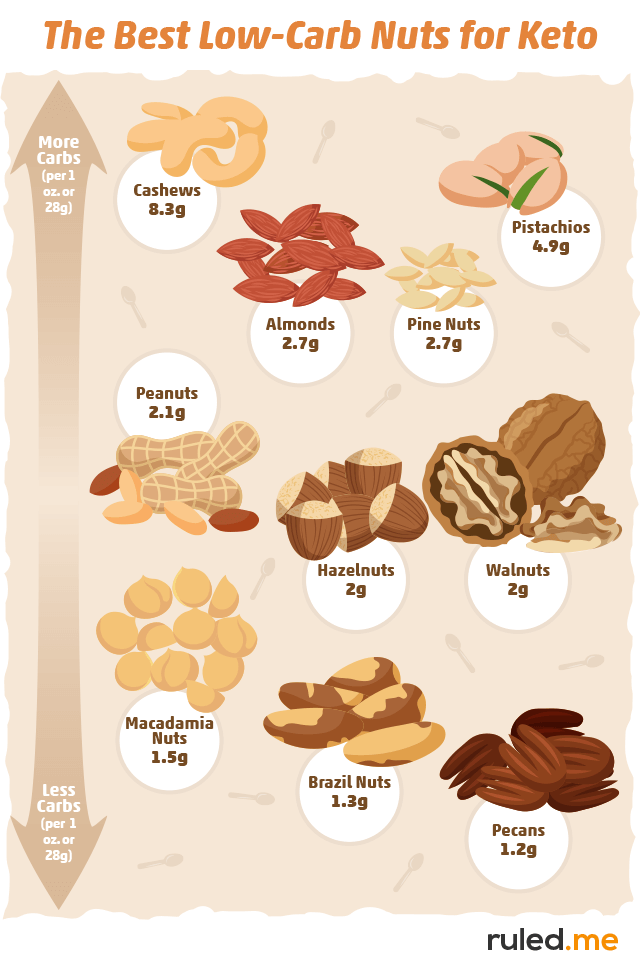
A List of Highest Fat Nuts for Keto
If you need a high-fat snack that’ll satisfy your hunger and keep you in ketosis, here are the best nuts (categorized from highest to lowest total fat per ounce):
- Macadamia nuts with 21.5 g
- Pecans with 20.2 g
- Pine nuts with 19.1 g
- Brazil nuts with 18.6 g
- Walnuts with 18.5 g
- Hazelnuts with 17 g
- Peanuts and Almonds with 13.8 g
Since macadamia nuts, pecans, and brazil nuts also have the lowest net carb content, these would be the best options for increasing your fat intake on keto.
That being said, almost any nut can have its place in your keto lifestyle. Let’s take a closer look at each option, including their carb counts, health benefits, intake recommendations, and recipes.
A List of the Best Nuts for Keto
Carbs in Walnuts
With only 2 grams of net carbs per ounce, walnuts are an excellent choice for keto. Along with being low in carbs, they are loaded with health-promoting nutrients, such as B vitamins, iron, magnesium, zinc, antioxidants, fiber, and alpha-linolenic acid (ALA).
This amalgamation of nutrition is why walnuts are so well-known for their health benefits. In fact, studies have found that they can help improve heart & brain health, reduce blood pressure, regulate blood sugar, and increase weight loss.
Coincidentally, the ketogenic diet can provide many of the same benefits as well. It is likely that adding walnuts to your keto lifestyle will only boost your results.
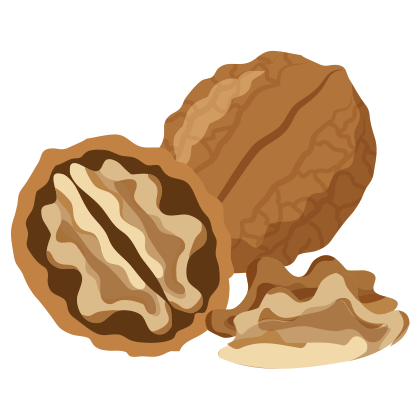
Other than eating raw walnuts, you can add them to your diet by making these delicious keto recipes:
You can even make each one for a full day of keto meals — keto zucchini bread for breakfast, the salad for lunch, and the salmon for dinner.
Carbs in Pecans
Depending on the source, pecans will be either the #1 lowest carb nut or in the top three (along with macadamias and brazil nuts). According to the USDA database, one ounce of pecans contains only 1.2 grams of net carbs.
They are also loaded with health-boosting nutrients like thiamine (vitamin B1), magnesium, phosphorus, zinc, oleic acid, and fiber. Similar to walnuts, research on pecan-rich diets has found them to benefit cardiovascular health and blood sugar control.
On the keto diet, you won’t have to skip the pecan pie, cookie, or ice cream either. Just make sure you use the right keto-friendly sweeteners and follow these keto recipes to get your pecan fix:

Or take the healthier route by adding pecans to your keto veggies with these recipes:
Carbs in Hazelnuts
Though hazelnuts are synonymous with unhealthy chocolate spreads (like Nutella), they have the same amount of net carbs as walnuts (at 2 g per ounce). You’ll also find that they are rich in healthy fats, fiber, vitamins E & K, antioxidants, and a blood-pressure-lowering amino acid called L-arginine.
Studies have found that hazelnut-rich diets help protect against heart disease by reducing inflammation, lowering blood pressure, and decreasing LDL cholesterol levels. You can reap these benefits on keto in several ways:
- Snacking on hazelnuts (21 hazelnuts = roughly 17 g of fat and 2 g of net carbs)
- Making Keto Caramel Pecan Pie (which features three keto nuts: pecans, almonds, and hazelnuts)
- Create your own Keto Nutella. Use our macadamia nut butter recipe as a guide, replace the macadamias with hazelnuts, and blend in ⅛ to ¼ cup of unsweetened cocoa powder.
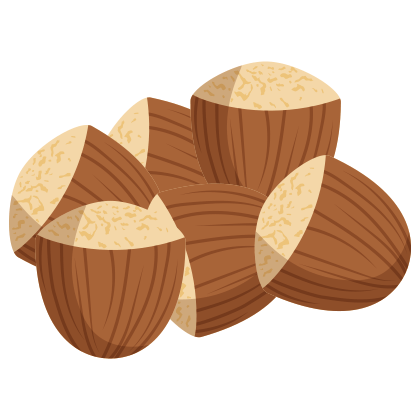
Carbs in Almonds
Almonds are one of the most widely consumed keto-friendly nuts. They can be eaten as a simple snack, used as a reliable low-carb flour substitute, made into a tasty nut butter, and transformed into keto-friendly milk.
Research on almonds is promising as well. Studies have shown that a diet rich in almonds promotes weight loss by promoting fullness and curbing cravings.
On the keto diet, your primary source of almonds will likely be from almond flour. With the help of this low-carb flour, you can make keto-friendly pancakes, muffins, cookies, and even bread.
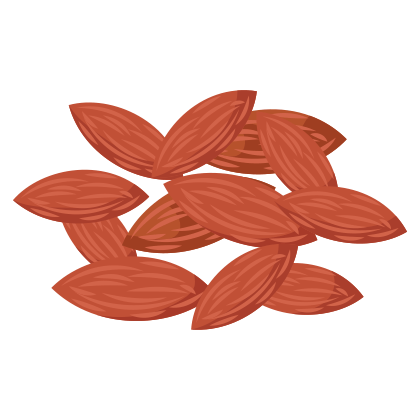
However, make sure you proceed with caution when adding baked goods to your keto diet. Almond flour is calorically dense and contains around 8 grams of net carbs in ½ cup. When consumed in high quantities, it can slow weight loss and keep you from the benefits of ketosis.
Carbs in Macadamia Nuts
Macadamias and keto go together beautifully. In fact, we dedicated an entire article to this incredible low-carb nut.
Here’s a quick overview of why macadamias are a great option for keto from a health perspective:
- They have only 1.5 g of net carbs per ounce.
- They contain the most thiamin (vitamin B1) compared to the other low-carb nuts.
- They have more manganese than most nuts, which plays a crucial role in the production of digestive enzymes, bones, and immune-system defenses.
- They provide us with more healthy monounsaturated fats than any other nut.

To add more of these nutritional powerhouses to your diet, feel free to eat them raw, roast them, blend them into a keto nut butter, or make a macadamia-nut-based keto-friendly recipe:
- Low Carb Macadamia Nut Brownies
- Speculoos and Macadamia Biscotti
- Roasted Celery and Macadamia Cheese
Carbs in Brazil Nuts
Brazil nuts are one of the top three lowest carb nuts with 1.3 g of net carbs per ounce.
Their claim to fame, however, is their selenium content.
Selenium is an essential trace mineral that is important for many processes throughout the body, such as building a healthy immune system, improving cognitive health, and maintaining fertility in both men and women. It also plays a crucial role in thyroid hormone metabolism (similar to iodine).
On average, one brazil nut is all you need to get 100% or more of your recommended daily allowance. This makes it the perfect nut for anyone following a keto diet that is deficient in selenium. (check out our guide to micronutrients if you’d like to learn about other high-selenium foods for keto.)

That being said, the National Institutes of Health recommends that adults keep their intake to under four nuts per day to avoid surpassing the upper limit for selenium (which is 400 mcg).
For this reason, it is best to think of Brazil nuts as a keto-friendly selenium supplement instead of a snack. Look to the other low-carb nuts and recipes in this post for a satisfying high-fat option.
Carbs in Pine Nuts
Though they are relatively expensive, pine nuts are a unique treat worth adding to your keto lifestyle every once and awhile. Since they are sourced from the cones of pine trees, they will have a distinct flavor and assortment of nutrients that you won’t find in other low carb nuts.
Overall, pine nuts have 2.7 g of net carbs per ounce (which is the same as raw almonds) and are particularly high in vitamin E, manganese, magnesium, vitamin K, zinc, copper, and phosphorus. Like many other nuts, pine nuts have been shown to promote heart health and weight loss.
Feel free to add these tasty morsels to your homemade trail mixes, sprinkle them on salads, or eat them raw. And of course, don’t forget to try a keto pesto dish:
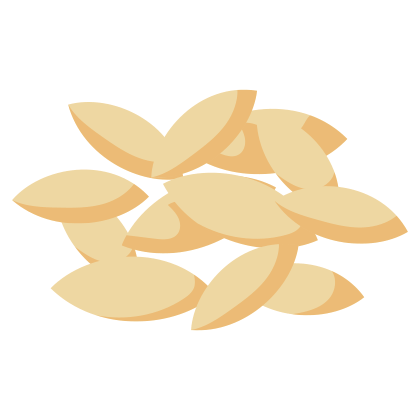
Carbs in Peanuts
Though peanuts are technically legumes, they belong in the nut category from a culinary and nutrition perspective. With only 2.1 g of net carbs per ounce and a uniquely satisfying flavor, they are a great high-fat option for any keto diet.
Peanuts are also rich in anti-aging antioxidants, vitamins, minerals, and choline. In fact, the current literature has found peanuts to elicit many of the same weight loss and heart health benefits as the other low-carb nuts.
You’ll also find peanuts to be one of the most versatile and flavorful keto ingredients. Here are some of the most satisfying examples of what you can do with these ”nuts” :
- Thai Peanut Shrimp Curry
- Peanut Butter Caramel Milkshake
- Low Carb Mock Snickers Bar
- Spicy Peanut Tofu Lettuce Cups (a vegan-friendly keto option)

Carbs in Pistachios
Pistachios are a great source of healthy fats, fiber, protein, antioxidants, and B-vitamins.
Though it is a lower calorie nut, it is much higher in net carbs than the other options mentioned above. Just one ounce will increase your net carb intake by 4.9 grams.
For this reason, you should limit your consumption of pistachios for a successful keto diet.
As an example, instead of snacking on pistachios, try making a keto recipe that features a few nuts per serving like these Pistachio and Pumpkin Chocolate Muffins.

Carbs in Cashews
Just like the other nuts, cashews provide us with vitamins, minerals, and other beneficial compounds. Unfortunately, they are filled with net carbs as well.
At 8.3 grams of net carbs per 1 ounce (which is roughly 18 cashews), each cashew comes with just under 0.5 grams of net carbs. For this reason, it is best to avoid cashews on a keto diet.
Opt for dry roasted macadamias instead. These will have the flavors you crave from cashews without the excess carbs.

What About Low-carb Nut Butters? Buying Tips and Suggestions
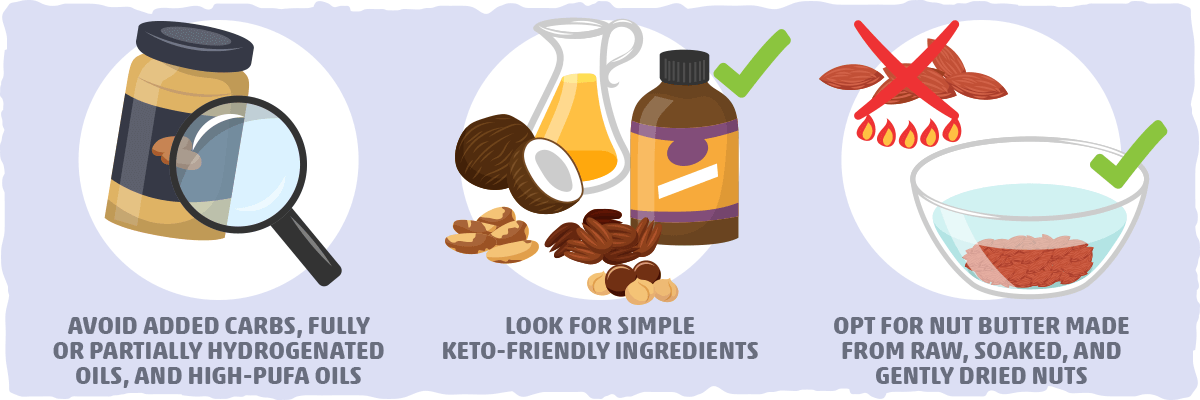
There is nothing like the rich, satisfying creaminess of nut butter. Regardless if it’s made from peanuts, almonds, hazelnuts, and/or macadamia, it is a treat like nothing else.
Unfortunately, many popular nut butter products will come with added carbs and unhealthy oils. This is why it is crucial that you read labels carefully.
When you are looking for the right peanut butter, nut butter, or seed butter for keto, follow these guidelines:
- Avoid added carbs, fully or partially hydrogenated oils, and high-PUFA oils. Common carb-rich ingredients you may find are sugar, cane sugar, dates, maple syrup, and honey. If they use oil, make sure it is one you’d normally eat on keto. For a comprehensive list of what oils to avoid, follow this link.
- Look for simple keto-friendly ingredients. Two ingredient products that solely consist of a low-carb nut and salt are usually best. Keto nut butter products made with MCT oil, coconut oil, spices, and/or keto sweeteners are good options as well.
- Opt for nut butter made from raw nuts when possible. Though roasted nuts are more common, the roasting process can breakdown some of the delicate fats in the nuts, turning them into unhealthy by-products. Nut butter from raw, soaked, and gently dried nuts are usually the healthier option.
In general, the healthiest and least expensive keto nut butter will be one that you make yourself. If you want to take the DIY route, use our macadamia nut butter recipe as your guide.
Feel free to customize the recipe with your favorite nut(s), seed(s), spices, keto sweeteners, and healthy oils. Here are some delicious low-carb nut butter ideas to get you started:
- Sub out the coconut oil for MCT oil to create a nut butter that increases your ketone levels significantly.
- Add in cinnamon, pumpkin spice, sugar-free vanilla extract, and/or cocoa powder for some extra flavor.
- Use multiple nuts or blend in some low-carb seeds for more nutrients, flavor, fat, and fiber.
The Best Seeds for Keto Diet
Seeds are an important part of the keto diet as well, especially for anyone with nut allergies. Not only are they packed with healthy fats, fiber, micronutrients, and antioxidants, but they play several crucial roles in keto cooking and baking as well.
Below you’ll find a nutrition chart of the most used seeds on keto. For reference, we also provided a rough estimate of how many tablespoons of the given seed will measure out to an ounce.
The table is ranked from the lowest to highest net carb content.
| Nutrients per 1 ounce (weight) | |||||||
| Seed Variety | Approx. amount | Calories (kcal) | Protein (g) | Total Fat (g) | Net Carbs (g) | Carbs (g) | Fiber (g) |
| Flax | 4 tbsp of whole seeds | 150 | 5.1 | 11.8 | 0.4 | 8.1 | 7.6 |
| Hemp | 1 ⅔ tbsp of raw hulled seeds | 161 | 9.2 | 12.3 | 1.3 | 3.3 | 2 |
| Chia | 2 ¾ tbsp of whole seeds | 137 | 4.4 | 8.6 | 1.7 | 12.3 | 10.6 |
| Sunflower | 3 tbsp of whole dried seeds | 164 | 5.8 | 14.4 | 3.2 | 5.6 | 2.4 |
| Sesame | 3 tbsp of whole dried seeds | 160 | 5 | 13.9 | 3.3 | 6.6 | 3.3 |
| Pumpkin | 3 1/2 tbsp of whole dried seeds | 151 | 7 | 13 | 3.3 | 5 | 1.7 |
Here’s a graphic you can save that summarizes the list:
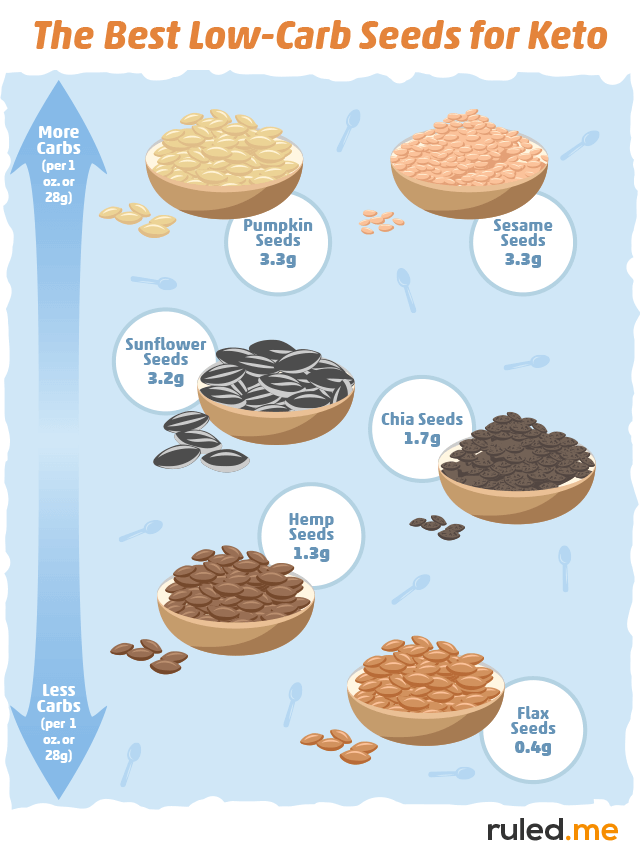
Chia Seeds — Keto Recipes, Carbs, and Nutrition
Though they are very low in net carbs (with 1.7 g per ounce), chia seeds are best known for their high amount of ALA (a type of omega-3 fatty acid), fiber, and calcium.
In fact, these seeds provide 3x more fiber than almonds, which is the highest-fiber nut on our list. This makes them one of the best sources of keto-friendly fiber.
When hydrated, chia seeds form a thick gel that can be used to thicken up your keto smoothie, create a chia pudding, or bind ingredients together. To experience the versatility and health benefits of chia seeds, try making some of these keto-friendly recipes:
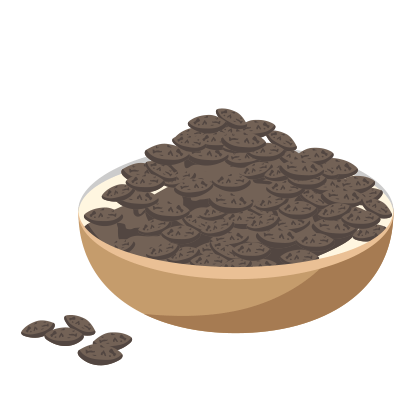
Flax Seeds — Keto Recipes, Carbs, and Nutrition
Flax seeds only have 0.4 grams of net carbs per ounce, making them the lowest carb seed. They are also super nutritious, providing a good source of fiber, vitamin B1, Copper, ALA, and lignans (plant compounds that can help ward off chronic diseases).
Perhaps the best thing about these seeds is the fact you’ll find them many of the most delicious keto recipes:
Flax seeds are a key ingredient in keto bread and low carb tortillas as well.
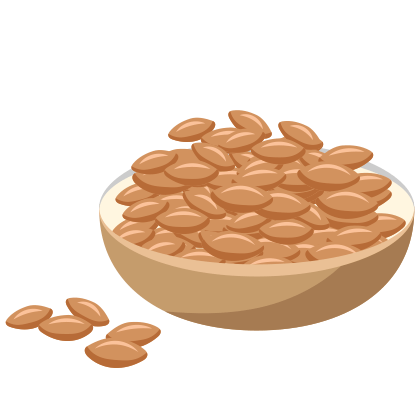
Hemp Seeds — Keto Recipes, Carbs, and Nutrition
Though they only have trace amounts of CBD, hemp seeds still come with anti-inflammatory benefits due to their high gamma-linolenic acid (GLA) content.
If you’re looking for a way to increase your protein and fiber intake that is both vegan and keto-friendly, you’ll find hemp seeds to be one of the best options (especially since they only have 1.3 g of net carbs per ounce).
When combined with walnuts, they can even add a meat-like texture to savory plant-based dishes like these meatless taco stuffed avocados.
Or — for something that’ll satisfy your sweet tooth — try making this dairy-free chocolate shake. This thick, satisfying milkshake is 100% vegan and filled with healthy fats, fiber, and plant-based protein from these low-carb seeds.
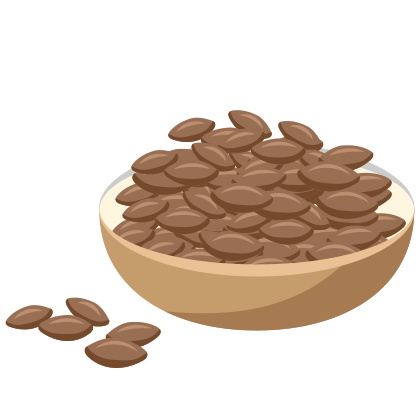
Sesame Seeds — Keto Recipes, Carbs, and Nutrition
These tiny white seeds are brimming with a surprising amount of flavor and nutrition. Sesame seeds are rich in disease-fighting lignans and health-boosting phytosterols that can help reduce the risk of heart disease.
Since they are relatively high in net carbs (with 3.3 grams per ounce) and too small to snack on, these seeds should only be used as a flavor-boosting garnish for keto recipes like these:
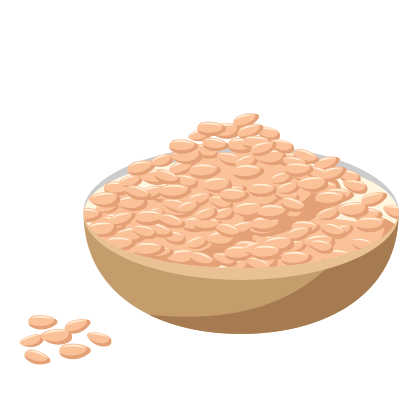
Sunflower Seeds — Keto Recipes, Carbs, and Nutrition
Sunflower seeds provide keto dieters with a great source of magnesium (which can help remedy some keto flu symptoms) and vitamin E (which helps protect blood vessels and brain tissue from oxidative damage).
In terms of flavor, texture, and versatility, sunflower seeds are the best substitute for peanuts and keto nuts. If you have a peanut and/or nut allergy, sunflower seeds will be your saving grace.
Sugar-free sunflower seed butter can be used as a direct replacement for any keto recipe that calls for peanut butter, almond butter, or any other nut butter. You can even make your own by replacing the macadamia nuts in our keto nut butter recipe.
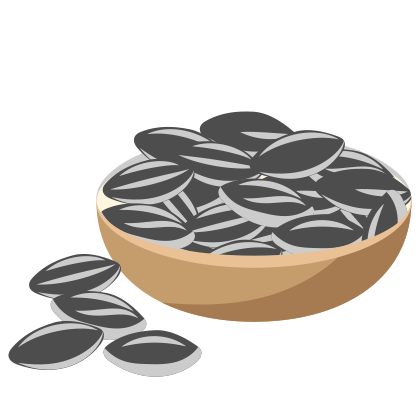
Sunflower seed flour can be used as a substitute for other low-carb flours as well. To learn more about how you can do this, check out our comprehensive guide to keto flour substitutions.
Keep in mind, however, that sunflower seeds contain 3.2 grams of net carbs per ounce (which comes out to ~3 tablespoons). This means they are a bit higher in net carbs than almonds.
For a reliable keto-friendly way to add more sunflower seeds to your diet, try making these Mini Pumpkin Spice Muffins.
Pumpkin Seeds — Nutrition, Carbs, and Tips
Also known as pepitas, this mildly nutty seed provides us with protein, healthy fats, magnesium, manganese, phosphorus, and cholesterol-lowering phytosterols.
On the keto diet, these seeds will make a great snack or a flavorful garnish that will add nutrition to your keto salads.
However, make sure you are mindful of how much you are eating. Pumpkin seeds are one of the highest carb seeds with 3.3 g of net carbs per ounce (~3 ½ tbs).
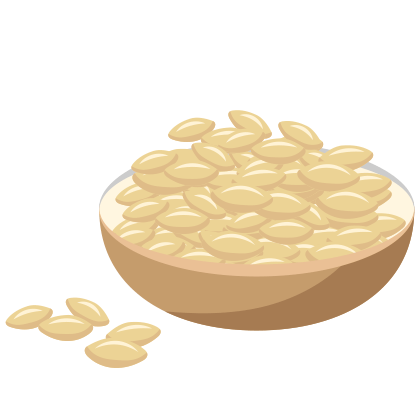
How to Add More Seeds & Nuts on Keto
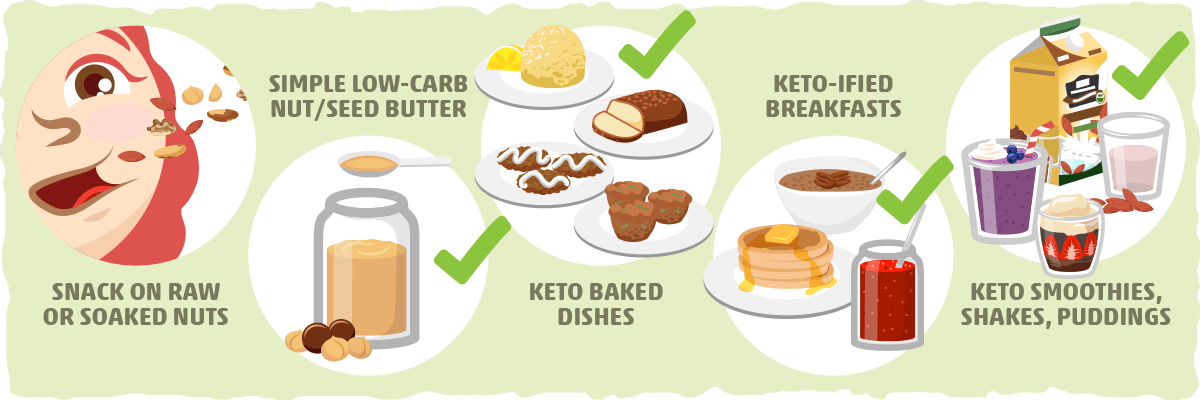
Nuts and seeds are a great way to fit more healthy fats, vitamins, minerals, fiber, and other health-promoting compounds into your keto diet. Let’s take a look at the best ways to incorporate more of these nutritional powerhouses into your day:
- Snack on nuts. Opt for raw (and soaked for better digestibility) or dry roasted nuts. To make sure you aren’t over-snacking, use the nutrition charts found throughout this post to guide your portion sizes. For more ideas for snacking on the keto diet, explore a comprehensive list here.
- Low-carb nut (or seed) butter. The best keto nut or seed butter product will be one without any added sugars, partially/fully hydrogenated oils, or high-PUFA oils. For the cheapest and healthiest option, try making it yourself by using this recipe as your guide.
- Keto baked goods. Keto recipes for bread, muffins, cookies, and even cakes will call for nut flour(s) and/or seed meal.
- Keto-ified breakfast favorites. As with baked goods, you’ll find that many popular breakfast dishes feature nuts and/or seeds as well. Check out our keto pancake, waffle, and oatmeal recipes for some inspiration. You can even add some chia seed jam to your breakfast for extra fiber and flavor.
- Keto smoothies, shakes, and puddings. Flax seeds, chia seeds, and nut butter are often used to thicken them up while keto-friendly nut milk serves as the liquid base. This results in a super satiating smoothie, shake, or pudding. To experience this unique alchemy of nuts and seeds, give some of these recipes a try: Blueberry Banana Bread Smoothie, Dairy-Free Dark Chocolate Shake, Keto Neapolitan Chia Pudding.
However, as with any other keto food or recipe, it is crucial that you consider them in the broader context of your keto lifestyle.
Regardless of how low you keep your carb intake, you can still sabotage your weight loss results by eating too much fat. To get the results you expect from keto, we must take a look at the bigger picture.
But Don’t Go Nuts on Nuts: How to Avoid This Common Keto Mistake
Nuts are notoriously easy to overeat throughout the day. Over time, this can cause unexpected weight loss stalls and weight gain.
Why does this happen? Unfortunately, even when our carb intake is as low as possible, our body fat levels will still increase if we eat too much fat.
This is why it is crucial to be mindful of your nut intake on keto. To make sure you’re on the right track, we’ve included a few snacking tips and portioning guidelines:
- Measure out a daily portion. Use the nut nutrition table above to estimate or measure out 1-2 ounces of nuts, and limit yourself to that portion throughout the day. (Just make sure to put the bag of nuts away to avoid the temptation to add more.)
- Change your nut intake based on your results. If you notice your weight loss is plateauing after 2-3 weeks, decrease your nut consumption to encourage more fat loss. Conversely, if you are losing weight rapidly and struggling with fatigue, increase your nut intake to help provide energy and lose weight at a healthier pace.
- Eat 1 to 1.5 ounces of nuts when you are hungry and need energy. Use nuts as a healthy, high-fat snack to provide extra fuel and curb your appetite.
Keep in mind that these are only general recommendations. To ensure that you get the results you want, we must also consider your keto diet as a whole.
The Bigger Picture: Nuts, Seeds, and Your Keto Diet
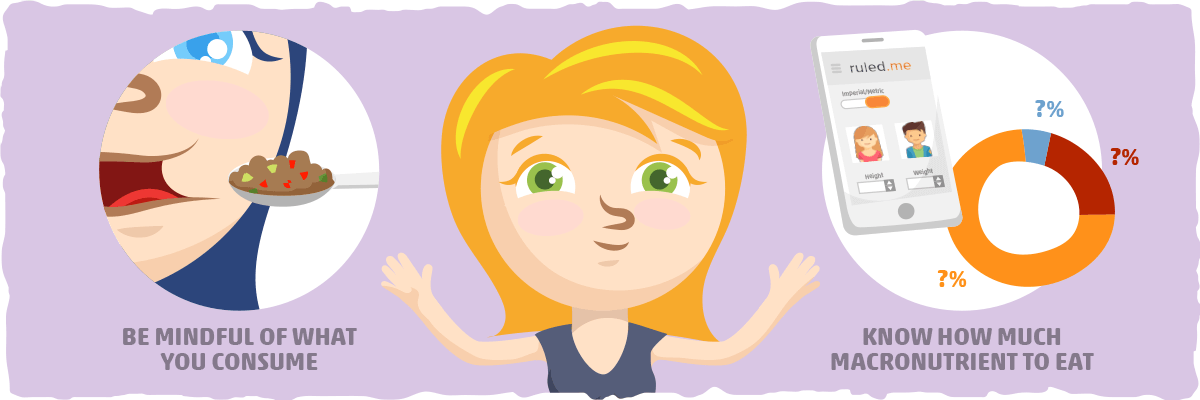
Even with the lowest carb nuts (i.e., pecans, brazil nuts, and macadamias), you will have to be mindful of your intake because the fat calories from them can add up quickly. This can cause you to overeat, which will slow weight loss (and can even promote body fat accumulation).
One of the critical steps to achieving your goals is knowing how much of each macronutrient (i.e., fat, protein, and carbs) you should aim to eat daily. The simplest way to do this is by using our keto calculator.
With these calculations, you’ll be able to formulate your keto meals in a way that allows you to indulge in your favorite nuts and nut-based recipes while achieving the results you want.
To help create the right diet for you, we’ve included links to a few helpful keto resources:
- The 10 Best Tips for Keto Diet Success
- A Comprehensive Guide to the Ketogenic Diet — All you need to know to get started with low-carb eating
- Keto Plateau Buster — Learn exactly what to do if your weight loss stalls.
Sources
- SELF Nutrition Data — SELF
- FoodData Central — USDA
- The Types of Fat: A Comprehensive Look at Good vs. Bad Fats — Ruled.me
- Health benefits of nuts in prevention and management of diabetes. — NCBI
- Nuts and Human Health Outcomes: A Systematic Review — NCBI
- Learn How To Avoid The Keto Flu [Symptoms & Remedies] — Ruled.me
- Selenium — NIH
- A Comprehensive Guide to Micronutrients — Ruled.me
- Naturally Lignan-Rich Foods: A Dietary Tool for Health Promotion? — NCBI
- 6 Super Healthy Seeds You Should Eat — Healthline
- Consumption of Plant Seeds and Cardiovascular Health: Epidemiologic and Clinical Trial Evidence — NCBI